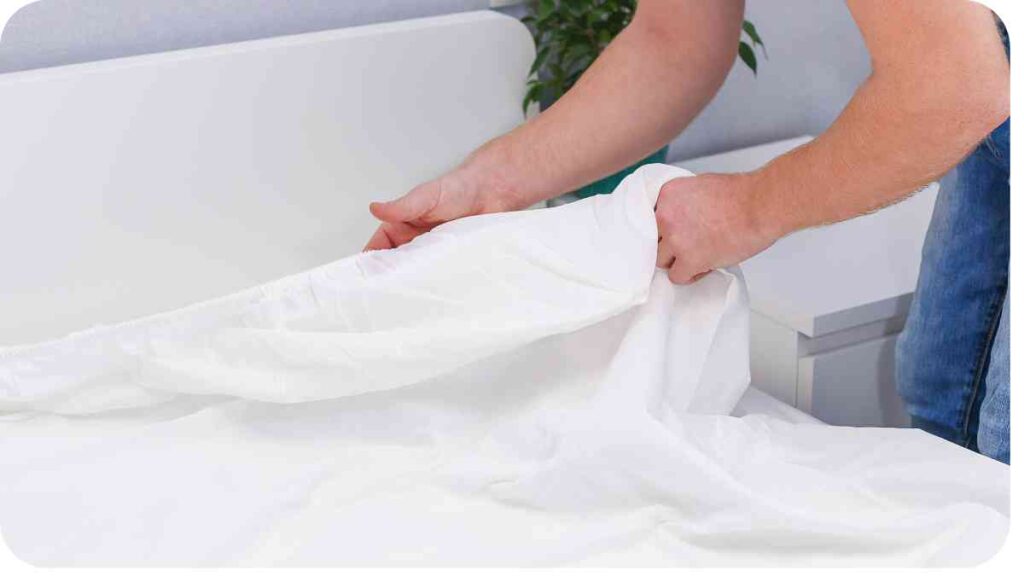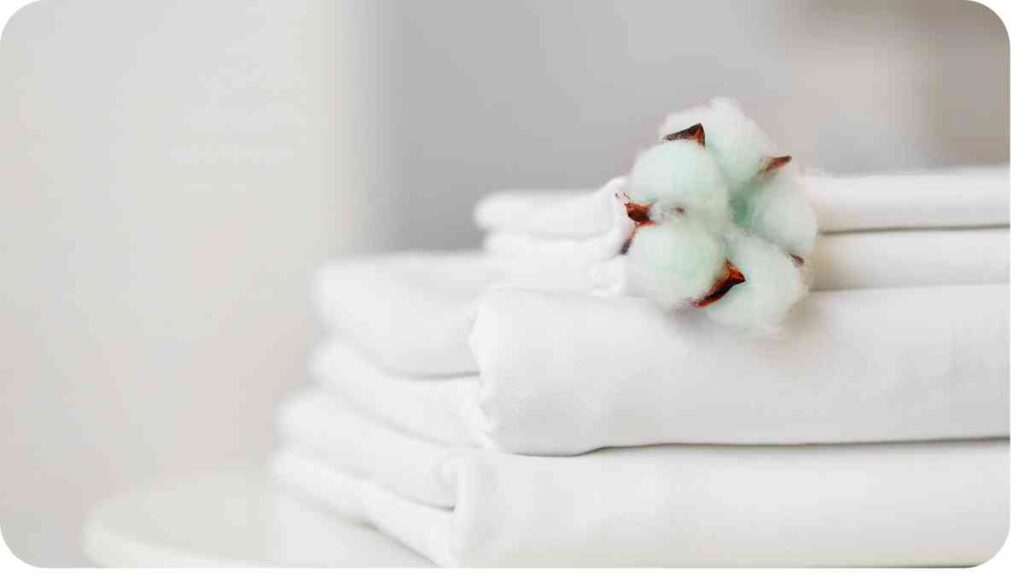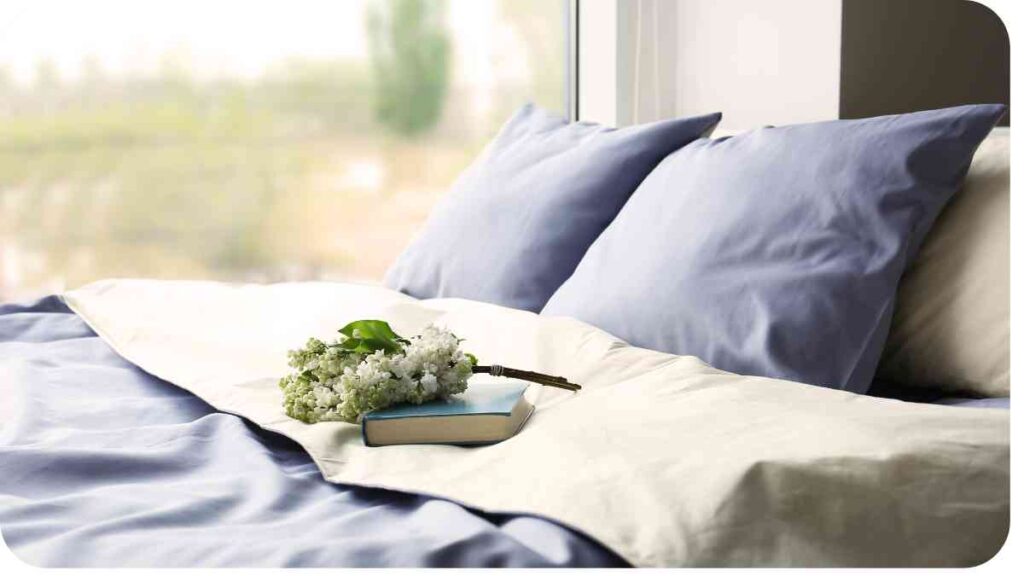If you’ve ever shopped for bed sheets, you may have come across the term “thread count.” Thread count is often mentioned as an indicator of quality and comfort, but understanding its significance can be quite confusing.
In this article, we’ll delve into the basics of thread count and its importance when choosing bed sheets. By the end, you’ll have a clear understanding of how thread count can enhance your sleep experiences.
| Takeaways |
|---|
| Consider thread count, but it’s not the sole indicator of quality in bed sheets. |
| Factors such as fabric type, weave patterns, and finishing techniques also contribute to the overall comfort and durability of sheets. |
| Personal preference and desired comfort should guide your selection of the ideal thread count for your bed sheets. |
| Higher thread count doesn’t always mean better quality; other factors, such as yarn thickness and fabric type, impact the feel of the sheets. |
| Look beyond thread count and consider facto |
2. The Importance of Thread Count in Bed Sheets

When it comes to our beds, we all want the best possible sleeping experience. Thread count plays a pivotal role in determining the overall quality, softness, and durability of bed sheets. A higher thread count generally indicates a smoother and more luxurious feel against the skin.
However, it’s important to note that thread count alone is not the sole factor to consider when purchasing bed sheets. To gain a thorough understanding of thread count, let’s explore its definition and how it is calculated.
Achieving optimal sleep requires more than just a cozy mattress. Explore our guide on bed sheet selection to ensure your bedding enhances your sleep quality.
3. Understanding Thread Count
What is Thread Count?
Thread count refers to the number of horizontal and vertical threads woven into one square inch of fabric. It is usually presented as a two-number value, such as 300 thread count or 1000 thread count.
The first number represents the vertical threads (warp), and the second number represents the horizontal threads (weft). The higher the thread count, the denser the weave and the more threads there are per square inch.
How is Thread Count Calculated?
Thread count is calculated by adding the number of vertical threads (warp) and horizontal threads (weft) together. For example, if a fabric has 300 vertical threads (warp) and 300 horizontal threads (weft), the thread count would be 600. It’s important to emphasize that thread count is not the only factor in determining the quality of bed sheets.
Transform your bedroom into a haven of comfort and style. Dive into our ultimate bedroom decor guide to discover tips and tricks for crafting a cozy retreat that reflects your personal style.
The Significance of Higher Thread Counts
While higher thread counts are often associated with superior quality, it’s essential to note that the relationship between thread count and the feel of bed sheets is subjective. Higher thread count bed sheets are generally softer and more comfortable.
However, there is a point of diminishing returns where an extremely high thread count might not provide a noticeable difference in comfort. It’s important to strike a balance and consider other factors to find the perfect sheet for your needs.
Choosing the Right Thread Count for Different Needs
The appropriate thread count for your bed sheets depends on your personal preferences and circumstances. For those who prefer a crisper, lighter feel, bed sheets with a thread count of 200 to 400 are recommended.
On the other hand, if you prefer a smoother and more luxurious feel, bed sheets with a thread count of 400 to 800 will provide a silky touch. For the ultimate indulgence in comfort, thread counts above 800 can be considered.
Discover the secrets to a serene bedroom oasis with our curated top 10 tips. From soothing colors to smart organization, elevate your space for a relaxing and comfortable ambiance.
4. Factors Affecting Thread Count

While thread count is an important consideration, it’s not the sole determinant of bed sheet quality. Several other factors play a crucial role in the overall comfort and longevity of bed sheets. Let’s explore some of these factors.
Yarn Thickness and Ply
The thickness of the yarn used in bed sheet construction can significantly impact the feel and durability of the fabric. A finer yarn tends to result in a higher thread count and a smoother feel. Additionally, the ply of the yarn can affect the overall quality. Single-ply sheets are made from single threads, while two-ply sheets use twisted yarn for added strength and longevity.
Types of Weave
The weave pattern used in bed sheet manufacturing can affect the overall feel, breathability, and appearance of the fabric. Common weave patterns include percale, sateen, and satin. Percale weave provides a crisp and cool feel, while sateen weave is known for its lustrous and silky texture. Satin weave, on the other hand, creates a smooth and shiny fabric.
Each weave has its unique characteristics, and choosing the right one depends on personal preference and desired comfort.
Quality of Materials
The quality of materials used in bed sheet production is another crucial factor. While cotton is the most popular choice due to its breathability, softness, and durability, not all cotton is created equal. Egyptian cotton, for example, is renowned for its long and fine fibers, contributing to a luxurious feel.
Supima cotton, grown in the United States, is also highly regarded for its superior quality. Other materials like linen and bamboo blend sheets offer different textures and qualities worth exploring.
5. Debunking Common Misconceptions
Thread count has its importance, but it’s essential to debunk a few common misconceptions surrounding it. Higher thread count doesn’t always mean better quality or comfort. Some manufacturers achieve higher thread counts by using multi-ply threads or fine yarns twisted together, which can inflate the thread count but not necessarily improve the quality.
It’s crucial to consider other factors discussed previously to make an informed decision when purchasing bed sheets.
Unravel the mysteries of cotton fabrics with our comprehensive guide to different types of cotton. From Egyptian to Pima, explore the characteristics that make each cotton variety unique, aiding your fabric selection.
6. How to Determine Quality Beyond Thread Count
As mentioned earlier, thread count is not the sole determinant of bed sheet quality. Consider these additional factors to ensure you’re investing in high-quality bed sheets:
Fabric Type
Different fabric types offer their unique characteristics and benefits. Cotton is widely popular, but there are variations like Egyptian cotton or Supima cotton that provide exceptional quality.
Linen offers breathability and a textured feel, while bamboo blend sheets offer a silky and hypoallergenic option. Understanding fabric types allows you to choose one that aligns with your preferences and desired comfort.
Cotton Grades
Within the cotton category, different grades exist, indicating the purity and quality of the fibers. Long-staple cotton, such as Egyptian cotton or Supima cotton, tends to produce smoother and more durable bed sheets. Look for these grades when aiming for superior quality.
Weave Patterns
As mentioned earlier, different weave patterns offer varying feel and appearance. Determine which weave pattern suits your preferences and desired comfort, whether you prefer a crisp and cool feel or a smooth and luxurious texture.
Finishing Techniques
Finishing techniques used during the manufacturing process can enhance the softness, durability, and appearance of bed sheets. Look for sheets that are treated with techniques like mercerization or enzyme washing for improved qualities.
Certifications and Standards
Several certifications and standards exist within the textile industry that can indicate the quality, sustainability, and ethical practices of bed sheet manufacturers. Certifications like Oeko-Tex Standard 100 and Global Organic Textile Standard (GOTS) ensure that the sheets are free from harmful substances and are produced with environmentally friendly practices.
7. Taking Care of High Thread Count Bed Sheets

Once you’ve invested in high thread count bed sheets, proper care is essential to maintain their quality and longevity. Follow these tips to ensure your sheets provide long-lasting comfort:
Delve into the scientific aspects of sleep with our exploration on the impact of bedding. Learn how factors such as thread count and fabric influence your sleep quality, ensuring a restful night’s sleep.
Washing Tips
Always follow the manufacturer’s washing instructions. Generally, it’s recommended to machine wash your bed sheets in cold or warm water with a gentle cycle. Use a mild detergent, and avoid bleach or harsh chemicals that may damage the fabric.
Drying and Ironing Recommendations
When drying your bed sheets, opt for a low heat setting or line dry them if possible. High heat can weaken the fabric fibers and reduce their softness. Iron the sheets on a low heat setting if desired, or remove them from the dryer promptly to minimize wrinkles.
Storing and Maintaining
Proper storage is important to prevent damage and maintain the quality of your bed sheets. Make sure they are completely dry before folding and storing them in a cool and dry place. Avoid storing them in direct sunlight or damp areas to prevent discoloration or mold growth.
8. Finding the Perfect Thread Count for You
Selecting the ideal thread count depends on various factors, including your sleep preferences, the climate you live in, and your personal budget. Consider the following when choosing the perfect thread count for your bed sheets:
Sleep Preferences and Seasons
If you prefer a crisp and lightweight feel, a thread count of around 200 to 400 may be suitable. For a smoother and more luxurious experience, consider a thread count between 400 and 800. Higher thread counts above 800 provide the ultimate indulgence in comfort, especially for those who desire a silky touch.
Climate Considerations
Consider the climate and seasons in your area when choosing bed sheets. In warmer climates, lighter and more breathable sheets with lower thread counts might be more comfortable. In colder climates, you may prefer thicker and cozier sheets with higher thread counts.
Personal Budget
Lastly, your personal budget plays a role in determining the thread count you can afford. While higher thread count sheets tend to be more expensive, there are options available at different price points. Consider your budget and prioritize the factors that are most important to you, such as fabric type or quality of materials, to find the perfect balance between affordability and quality.
9. Conclusion
Understanding thread count is essential when choosing bed sheets that provide comfort and durability. While thread count is an important factor, it’s not the sole indicator of quality. Factors like yarn thickness, weave patterns, fabric type, finishing techniques, and certifications also play a significant role in determining the overall comfort and longevity of bed sheets.
When selecting bed sheets, consider your personal preferences, sleep habits, climate, budget, and the quality beyond thread count. By carefully evaluating these factors, you can make an informed decision and invest in bed sheets that offer a perfect balance of comfort, durability, and value for your sleeping experience.
Remember, thread count is just one piece of the puzzle. Don’t be solely fixated on achieving the highest thread count possible. Pay attention to other factors discussed in this article and leverage your own experiences and expertise to find the bed sheets that will provide you with the ultimate comfort and relaxation you deserve.
Sleep well!
Further Reading
Here are some additional resources to further explore the topic of thread count in bed sheets:
- Sealy: Does Higher Thread Count Mean Better Quality?: This article from Sealy provides insights into the relationship between thread count and quality, debunking common misconceptions and offering helpful tips.
- HGTV: A Guide to Buying Sheets: HGTV offers a comprehensive guide to buying sheets, including information on thread count, fabric types, and tips for selecting the perfect sheets for your needs.
- Sleep Foundation: The Best Thread Count for Sheets: The Sleep Foundation provides valuable information on finding the best thread count for sheets, taking into account factors such as personal preference, fabric type, and thread count myths.
FAQs
Here are some frequently asked questions about thread count in bed sheets:
What is the ideal thread count for bed sheets?
The ideal thread count for bed sheets depends on personal preference and desired comfort. Some prefer a crisp and lightweight feel, which can be achieved with a thread count of around 200-400. Others prefer a smoother and more luxurious feel, which can be found in sheets with a thread count of 400-800. Ultimately, choose a thread count that aligns with your own comfort preferences.
Does a higher thread count mean better quality?
Not necessarily. While a higher thread count can indicate a denser weave and potentially softer sheets, it is not the sole determinant of quality.
Factors such as yarn thickness, fabric type, and finishing techniques also contribute to the overall quality and feel of the sheets. It’s important to consider multiple factors when evaluating the quality of bed sheets.
Are higher thread count sheets more durable?
Not always. While higher thread count sheets can provide a luxurious feel, they may not necessarily be more durable.
Other factors, such as the quality of materials and weave patterns, play a significant role in determining the durability of bed sheets. It’s important to consider these factors in conjunction with thread count for long-lasting sheets.
Can I trust the thread count mentioned on the packaging?
While thread count is a widely used metric, it’s important to exercise caution. Some manufacturers may employ misleading techniques, such as using multi-ply threads or including non-functional fibers, to artificially inflate the thread count. Instead of solely relying on thread count, consider other factors and reputable brands to ensure the sheets’ quality.
Are there other factors to consider when purchasing bed sheets?
Yes, thread count is just one factor. Other important considerations include fabric type, weave patterns, quality of materials, certifications, and personal preferences. Each of these factors can impact the overall feel, breathability, and durability of the bed sheets. Take a holistic approach when evaluating and selecting the perfect sheets for your needs.

Hi, you! I’m Hellen James. I’m a beauty and fashion writer who loves to make the world a little more stylish and I’d love for you to join me in the fun! I’ve been writing about beauty and fashion since I was a kid, but it wasn’t until recently that I really knew what it meant to be a real expert.

